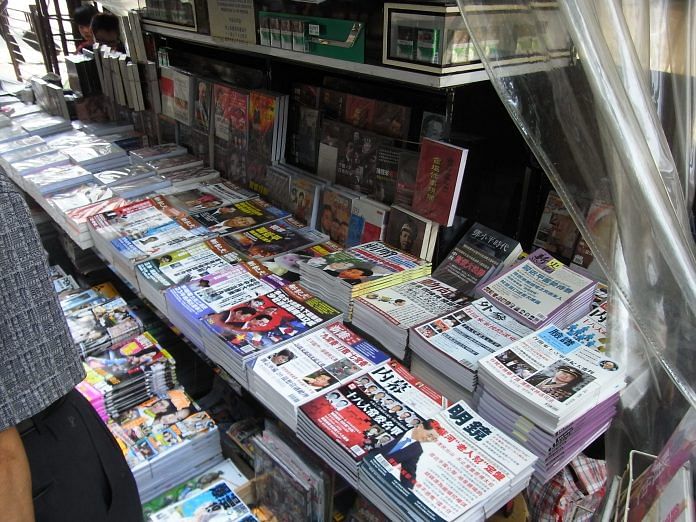Cultural ties between the two nations have never been stronger and the media in both nations should be careful about not eroding the gains made.
‘Incredible India’ has always fascinated the masses in China. They curiously look upon India and are amazed by the richness of its culture.
Rabindranath Tagore, not Mahatma Gandhi, is a household name here. Gandhi is restricted just to history textbooks. Raj Kapoor’s Awara still resonates with older generations. Presently, actor Aamir Khan enjoys unprecedented popularity among the Chinese youth, not Amitabh Bachchan or Shah Rukh Khan. These cultural icons have built a positive image of India in China. Bollywood music is among the favourites of senior citizens doing guangchang wu (public square dance) and in dance classes across China.
Yoga is popular among urban Chinese, and the Chinese Academy of Social Sciences (CASS), along with other think-tanks, recently released ‘Yoga Blue Book: China Yoga Industry Development Report’. It highlighted the fact that yoga is becoming one of the fastest growing categories in China’s health industry. According to statistics, around 14,146 yoga centres are spread across 132 cities in 31 provinces. The craze for yoga is growing, but in the form of exercise, not mediation.
Not long ago, Aamir Khan’s Dangal broke box office records in China to earn RMB 2,000 crore, and was scored 9.1/10 on DouBan, the Chinese equivalent of IMDb. While visiting Shanghai University, Khan met Li Dakang, who plays famous a character in popular Chinese TV anti-corruption serial In the name of People. These kinds of interactions have widened the popularity of cultural icons to the village level. This was similar to the time Jackie Chan appeared on Kapil Sharma’s show to promote Kung Fu Yoga.
But shortly after Doklam stand-off, the gain of soft power began to minimise. But it is also safe to infer that that peaceful disengagement at Doklam was to some extent possible because of increased interactions and complex interdependency between New Delhi and Beijing.
India’s soft power also helps attract Chinese tourists to India. In fact, the Chinese spent $261.1 billion last year on travelling worldwide and it’s expected to grow further. In 2016, 2.54 lakh Chinese travelled to India, while 6.76 lakh Indians visited China.
But India’s cultural charm offensive is overshadowed by the pugnacious media on both sides.
Contemporary India-China relations have become prisoner to media narratives. Fortunately, policy makers don’t fall prey to the ‘media trial’ as the successful disengagement from the 72-day-long Doklam stand-off indicates. In spite of reprinting a 1962 news clipping to remind and deter India about the previous war, Doklam led to a mutual disengagement.
It is not only the English media in China that survives on anti-India sentiment. The Indian media also propagates and twists news to check China. For instance, the news about the darkening of the Brahmaputra river, attributed to alleged Chinese construction, was later refuted by other media in India. As a matter of fact, the Chinese media also published detailed analysis for domestic readers, to refute China was behind the darkening of the water. This is not to say the media should not be vigilant to safeguard India’s interests, but it also should not fuel speculation. New Delhi and China must design a mutual mechanism to sort out such issues before it creates hurdles in the bilateral relationship, which is already a full basket of irritants.
The Indian media forgets that these belligerent headlines are used by Chinese media, quoting Indian sources, that India is nursing grudges and changing the regional security order. More importantly, translated news has much wider readership than the original, and can change perceptions of the common Chinese towards India.
Such reporting has not yielded the desired strategic gain, and has deteriorated the bilateral relationship, like in the case of hostility between India and Pakistan.
Most importantly, the Indian media is yet to differentiate between India-China competition and India-Pakistan hostilities, thereby using the same standard of reporting to provoke. On the other side, Chinese media is yet to realise that India is emerging and will not relent to any belligerent headlines and these sorts of tactics will not deter New Delhi from pursuing its national interests. Nonetheless, this kind of jingoism don’t serve the national interests of both countries, rather it fuels hate mongering.
The success story of the recently-released Aamir Khan-starrer Secret Superstar, which earned Rs 175 crore in three days in China, is proof that common people—especially the young in China—have not developed any hatred towards India in the backdrop of Doklam stand-off, and despite the belligerent media.
In comparison, when the THAAD missile defence system was deployed in South Korea, many Korean pop music icons were discouraged from performing in China and the broadcast of many TV serials were halted initially. Interestingly, there were no such public outrages against India’s soft power occurred during the Doklam stand-off. The Chinese public still doesn’t nurse an antipathy towards India.
It is now imperative that both the Indian and Chinese media change their orientation and strategy to positively contribute to strengthening ties, instead of eroding the layers of growing mutual trust and confidence in the relationship.
Rajiv Ranjan is an Assistant Professor at College of Liberal Arts, Shanghai University, China. He tweets @mrajivranjan.



